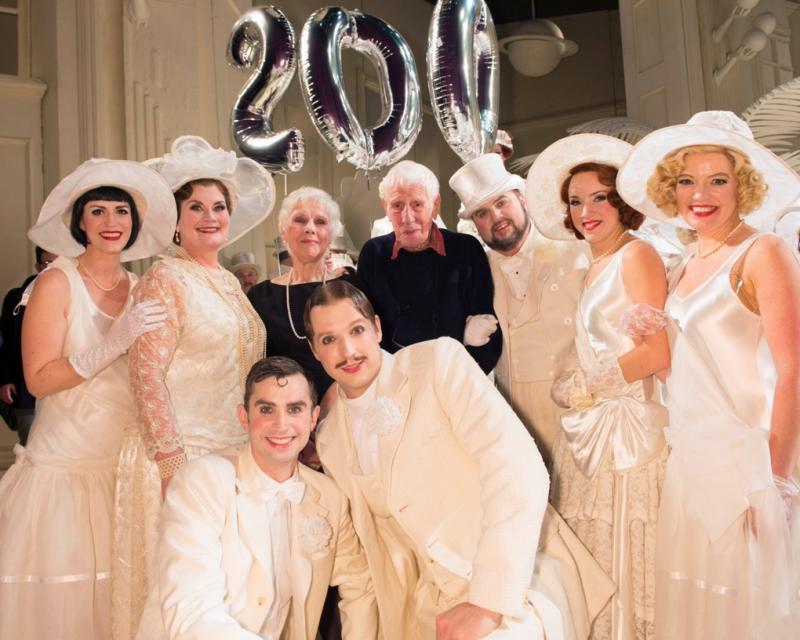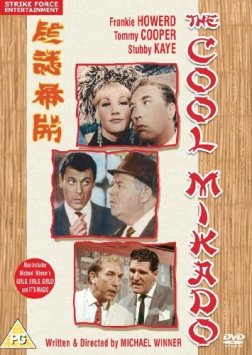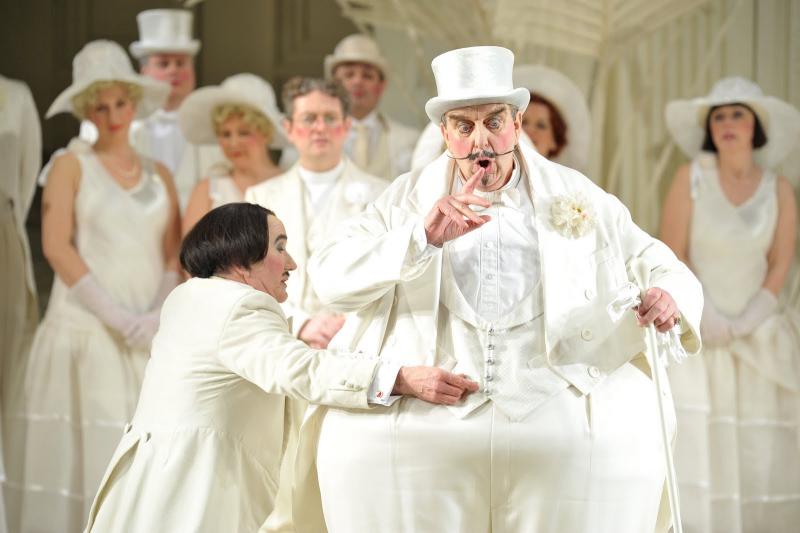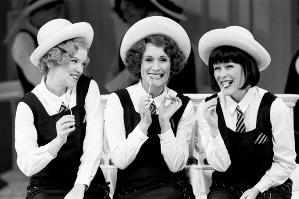200 Miller Mikados at ENO | reviews, news & interviews
200 Miller Mikados at ENO
200 Miller Mikados at ENO
Ko-Ko's still wielding a special little list as a white, tight craft sails on

Much of what follows was included in the 25th anniversary programme for Jonathan Miller’s legendary production of The Mikado at English National Opera. And the show goes on, still dazzling on each curtain-up thanks to the undated feat of the late Stefanos Laziridis’ sets and Sue Blane’s costumes, its routines absolutely classic on its 14th revival. On 6 December it marked its 200th performance, so there’s good reason to wheel out this celebration of sundry Mikados again.
First, a word about the revival. It was apt that the first ENO Charles Mackerras (Conducting) Fellow, 28-year-old Fergus Macleod, made his company debut in a work the master adored and conducted better than anybody (Mackerras was also young when he debuted with the-then Sadler’s Wells Orchestra, having already met his wife, Judy, as a player – he was an oboist, she a clarinettist. The great man, who died five years ago, would have been 90 on 17 November). Macleod’s mostly brisk speeds, underpinned by fabulous instrumental detail, hadn’t always gelled with the singers on the first night; they probably have now. Experience means communicating to those on stage as well as the players in the pit, and it takes time.
 The evening was one which I found myself grinning through, rather than laughing out loud very often. Inevitably there were a few belly laughs from Richard Suart’s vintage Ko-Ko, his “little list” updated to include FIFA shenanigans and Cameron’s youthful encounter with a – the word didn’t need to be rhymed amid the roars. Not everyone was up to the vintage mark, but George Humphreys made a rare impression as Pish-Tush, while Mary Bevan and Anthony Gregory (pictured above by Tristram Kenton) charmed as the young lovers (“cheeky bugger”, Bevan responded to a listings which announced she’d be showing us her Yum-Yum).
The evening was one which I found myself grinning through, rather than laughing out loud very often. Inevitably there were a few belly laughs from Richard Suart’s vintage Ko-Ko, his “little list” updated to include FIFA shenanigans and Cameron’s youthful encounter with a – the word didn’t need to be rhymed amid the roars. Not everyone was up to the vintage mark, but George Humphreys made a rare impression as Pish-Tush, while Mary Bevan and Anthony Gregory (pictured above by Tristram Kenton) charmed as the young lovers (“cheeky bugger”, Bevan responded to a listings which announced she’d be showing us her Yum-Yum).
It was back in 1986 that "the Miller Mikado" burst in all its white and black splendour on an unsuspecting public. Did it really mark the first decisive shift away from "all one sees that’s Japanese" (to quote a sham fleshly poet in a very different Gilbert and Sullivan operetta, Patience)? Not exactly.
The kimono, the fan and the (non-Japanese) snickersnee were to make unexpected comebacks in a resurrected Carl Rosa Opera Company production, not to mention the unexpected, exquisite costume drama of Mike Leigh’s Topsy-Turvy, surely the most truthful film about putting on a show ever made. But there had early on been "Texas Mikado" – as early as 1888, in print at least, unfolding the love of Yankee-Doo for By-Gum – as well as several jazz Mikados from Berlin and America, including one with Bill "Bojangles" Robinson in the title role.
 Later came a (presumably unspeakable) celluloid Cool Mikado (pictured right) starring Frankie Howerd and Tommy Cooper, directed – wait for it – by Michael Winner; the successful Black Mikado (which I think I’m right in saying led to Linda Lewis’s success with the pop hit "The moon and I", aka "The sun whose rays"); and Ned Sherrin’s The Metropolitan Mikado featuring Katisha, Countess of Grantham as well as wandering minstrel Red Ken singing "A gender-bender I".
Later came a (presumably unspeakable) celluloid Cool Mikado (pictured right) starring Frankie Howerd and Tommy Cooper, directed – wait for it – by Michael Winner; the successful Black Mikado (which I think I’m right in saying led to Linda Lewis’s success with the pop hit "The moon and I", aka "The sun whose rays"); and Ned Sherrin’s The Metropolitan Mikado featuring Katisha, Countess of Grantham as well as wandering minstrel Red Ken singing "A gender-bender I".
In the smaller world of opera and operetta, old traditions died harder. The D’Oyly Carte had suffered a slow, agonising death, finally giving up the ghost in 1982; a fierce resuscitation took place six years later, throwing up a few brilliantly inventive productions including a tight little HMS Pinafore at the Savoy with a cast including Della Jones as Little Buttercup, but that didn’t last long. And it is extraordinary to read that the elaborate Japanese costumes of the Savoy stagings which Gilbert had continued to oversee with such a fierce hold on correctness until his still-untimely death by drowning in 1911, had a remake for the Technicolor brilliance of the excellent 1936 film and were, in many cases, still being worn in the decadence of the 1970s and early 1980s. Actually not all the shows were quite as moribund even then as legend would have us believe; and I well remember being taken as a child to witness the inventiveness of the spoof last night, including a second act of The Pirates of Penzance with Frederic as played by Michael Crawford’s then-fashionable Frank Spencer in the sitcom Some Mothers Do ‘Ave ‘Em and the professional emergence of Doctor Evadne Hinge and Dame Hilda Bracket.
In Venice, there was a two-night veto of Suart’s Italian lyrics, which inevitably included a reference to Berlusconi
Even so, and especially in that context, the English National Opera production dazzled, and at least half of its continung success is that the look of the show, graced by Stefanos Lazaridis’s cream set and Sue Blane’s demi-fantastical costumes, is as brilliant, breathtaking even, as ever. Part of the watchword, back in 1986, came from GK Chesterton, who slightly overstated the case but proved generally sound when he wrote: "I doubt if there is a single joke in the whole play that fits the Japanese. But all the jokes in the play fit the English, if they would put on the cap." And he goes on to give a brilliant analysis of Pooh-Bah, the exclamation we are likely to make when in Blighty we "meet the same man twenty times as twenty different officials" (anyone remember Peter Mandelson not knowing who Pooh-Bah was on Radio 4's Today programme?) (pictured below by Chris Christodoulou in 2011: ENO's best-loved Mikado, Richard Angas (1942-2013), tailored by Richard Suart's irrepressible Ko-Ko).

Another seminal observation came from Beverly Nichols’ "always remember the importance of white when you are trying to form a mental picture of the Twenties". He cited Syrie Maugham, but Miller, Lazaridis and Blane looked across the Atlantic to the style we know so well from Fred and Ginger movies, especially Top Hat. Admittedly that’s stretching the timescale a bit to 1935, when the look was already tinted with nostalgia. But it’s worth remembering that the Gershwins never forgot their G&S, least of all in such pale successors affecting to spoof the political situation as Of Thee I Sing (how one longs even for The Grand Duke while waiting for the handful of good numbers). And Groucho Marx, the greatest comic example of all whose slightly cruel comic interplay with Margaret Dumont would seem to give a cue to Miller’s way with his Ko-Ko and Katisha, was a very idiosyncratic High Lord Executioner whose performance has been preserved on disc.
 The Groucho habit of bringing on a comic with a passably good ear in music kicked in immediately when Eric Idle played the first ENO Ko-Ko. On tour in Los Angeles, it was Dudley Moore for the chop, leading the next comedian, Bill Oddie, to quip in a quirky programme biography that "he only got the role because, due to financial cutbacks, the wardrobe was not allowed to alter Mr Moore’s costumes and Mr Oddie was the only one who’d fit into them (Little Jimmy Crankie was not available)": no, don’t go there... Assigned a couple of performances which the Goodie couldn’t make, Richard Suart snuck into Ko-Ko’s shorts, and the rest is history – though Suart (pictured above by Bill Cooper) records without rancour the difficulty he had in persuading ENO management that it was the show people came to see, not any celebrity executioner.
The Groucho habit of bringing on a comic with a passably good ear in music kicked in immediately when Eric Idle played the first ENO Ko-Ko. On tour in Los Angeles, it was Dudley Moore for the chop, leading the next comedian, Bill Oddie, to quip in a quirky programme biography that "he only got the role because, due to financial cutbacks, the wardrobe was not allowed to alter Mr Moore’s costumes and Mr Oddie was the only one who’d fit into them (Little Jimmy Crankie was not available)": no, don’t go there... Assigned a couple of performances which the Goodie couldn’t make, Richard Suart snuck into Ko-Ko’s shorts, and the rest is history – though Suart (pictured above by Bill Cooper) records without rancour the difficulty he had in persuading ENO management that it was the show people came to see, not any celebrity executioner.
I warmly recommend Suart’s brilliant little book, written in conjunction with journalist, former Ko-Ko and one-time contibutor to theartsdesk contributor ASH Smyth, They’d none of ‘em be missed. It is, as the title suggests, an amiable ramble through all the alternatives of Ko-Ko’s little list which Suart, above all other interpreters, has led audiences increasingly to anticipate over the years. In spite of Gilbert’s strictures as impresario that the text should not be altered without his rare, express benediction, early performers were allowed to impersonate the leaders of the time, and cartoons down the ages have featured Harold Macmillan, Margaret Thatcher and – yes, Ian Mikardo, to name but a few, in Japanese attire (in an unpublished advertisement for the 1938 film, a giant head of Hitler was decidedly on the list).
 So it is hardly surprising if Suart, as the idiosyncratic social conscience of the Miller Mikado, should hold the key to world history as it’s unfolded in the past 27 years, and not just in easy swipes. The text for the loan of the production to New York City Opera had to be rapidly switched: the scheduled dress rehearsal took place on 13 September 2001, but verses ending "George Dubya’s on my list – that shrub’ll not be missed" had to be swiftly replaced with less sensitive American TV and cultural targets. The Venice premiere in La Fenice’s temporary home on the island of Tronchetto marked the only time when censorship intervened: there was a two-night veto of Suart’s Italian lyrics, which inevitably included a reference to Berlusconi. The times change, the seasons alter, with the candidates: "the ornithologist" (that was for big brother Oddie), "Annus horribilis", "the Highgrove cannabist", "the Tellytubbyist", "the nodding iPodist". And so forth.
So it is hardly surprising if Suart, as the idiosyncratic social conscience of the Miller Mikado, should hold the key to world history as it’s unfolded in the past 27 years, and not just in easy swipes. The text for the loan of the production to New York City Opera had to be rapidly switched: the scheduled dress rehearsal took place on 13 September 2001, but verses ending "George Dubya’s on my list – that shrub’ll not be missed" had to be swiftly replaced with less sensitive American TV and cultural targets. The Venice premiere in La Fenice’s temporary home on the island of Tronchetto marked the only time when censorship intervened: there was a two-night veto of Suart’s Italian lyrics, which inevitably included a reference to Berlusconi. The times change, the seasons alter, with the candidates: "the ornithologist" (that was for big brother Oddie), "Annus horribilis", "the Highgrove cannabist", "the Tellytubbyist", "the nodding iPodist". And so forth.
If the major players on the world stage have all been well represented, it’s worth ending with a glance at all the great and/or well-loved names in the operatic world who’ve played their part here. ENO managements have come and gone, it’s true, their dafter follies incarnated in some of Suart’s more acid verses. But who would have thought that the first Yum-Yum, Lesley Garrett, would soon become one of the wider public’s favourite unofficial Dames, or that her successor, Susan Bullock, would graduate to a world-class Brünnhilde and Isolde (not entirely surprising, perhaps: "The sun whose rays" is a killer for stylish breath control)? And that's Janis Kelly, future Wainwright Prima Donna and Pat Nixon, as the Yum-Yum of the 1997 revival pictured in the centre above.
 We’ve all adored, and even come to love, Katishas Sarah Walker, Felicity Palmer (now a real Dame, pictured left with first Ko-Ko Eric Idle) and big-eyed Frances McCafferty. On the male side of the cast, we mourn the losses of designer Laziridis as well as master elocutionist Richard van Allan, definitive Mikado Richard Angas and Donald Adams (a great Pooh-Bah, but also the finest Mikado on the CD also featuring that other much-missed Savoyard Sir Charles Mackerras and the Nanki-Poo of much-mourned Anthony Rolfe-Johnson. Adams also proved a very fine Baron Ochs in Strauss’s Der Rosenkavalier under Mackerras). I’d like to note a personal debt, too, to Nicholas John, whose death in a mountain walking accident deprived us of a ground-breaking editor; today I’ve been looking back at his original Mikado programme, a model of good design and pithy information. They’re all of them very much missed, and inevitably remembered on an anniversary occasion such as this; but the show, thankfully, goes on, as surface bright and breezy as ever – with just an undercurrent of the hysteria and incipient threat which gives Miller’s production its special edge.
We’ve all adored, and even come to love, Katishas Sarah Walker, Felicity Palmer (now a real Dame, pictured left with first Ko-Ko Eric Idle) and big-eyed Frances McCafferty. On the male side of the cast, we mourn the losses of designer Laziridis as well as master elocutionist Richard van Allan, definitive Mikado Richard Angas and Donald Adams (a great Pooh-Bah, but also the finest Mikado on the CD also featuring that other much-missed Savoyard Sir Charles Mackerras and the Nanki-Poo of much-mourned Anthony Rolfe-Johnson. Adams also proved a very fine Baron Ochs in Strauss’s Der Rosenkavalier under Mackerras). I’d like to note a personal debt, too, to Nicholas John, whose death in a mountain walking accident deprived us of a ground-breaking editor; today I’ve been looking back at his original Mikado programme, a model of good design and pithy information. They’re all of them very much missed, and inevitably remembered on an anniversary occasion such as this; but the show, thankfully, goes on, as surface bright and breezy as ever – with just an undercurrent of the hysteria and incipient threat which gives Miller’s production its special edge.
Watch the old Thames documentary of Miller directing The Mikado (dig the 1980s hairdos)
Explore topics
Share this article
Add comment
The future of Arts Journalism
You can stop theartsdesk.com closing!
We urgently need financing to survive. Our fundraising drive has thus far raised £49,000 but we need to reach £100,000 or we will be forced to close. Please contribute here: https://gofund.me/c3f6033d
And if you can forward this information to anyone who might assist, we’d be grateful.

Subscribe to theartsdesk.com
Thank you for continuing to read our work on theartsdesk.com. For unlimited access to every article in its entirety, including our archive of more than 15,000 pieces, we're asking for £5 per month or £40 per year. We feel it's a very good deal, and hope you do too.
To take a subscription now simply click here.
And if you're looking for that extra gift for a friend or family member, why not treat them to a theartsdesk.com gift subscription?
more Opera
 The Railway Children, Glyndebourne review - right train, wrong station
Talent-loaded Mark-Anthony Turnage opera excursion heads down a mistaken track
The Railway Children, Glyndebourne review - right train, wrong station
Talent-loaded Mark-Anthony Turnage opera excursion heads down a mistaken track
 La bohème, Opera North review - still young at 32
Love and separation, ecstasy and heartbreak, in masterfully updated Puccini
La bohème, Opera North review - still young at 32
Love and separation, ecstasy and heartbreak, in masterfully updated Puccini
 Albert Herring, English National Opera review - a great comedy with depths fully realised
Britten’s delight was never made for the Coliseum, but it works on its first outing there
Albert Herring, English National Opera review - a great comedy with depths fully realised
Britten’s delight was never made for the Coliseum, but it works on its first outing there
 Carmen, English National Opera review - not quite dangerous
Hopes for Niamh O’Sullivan only partly fulfilled, though much good singing throughout
Carmen, English National Opera review - not quite dangerous
Hopes for Niamh O’Sullivan only partly fulfilled, though much good singing throughout
 Giustino, Linbury Theatre review - a stylish account of a slight opera
Gods, mortals and monsters do battle in Handel's charming drama
Giustino, Linbury Theatre review - a stylish account of a slight opera
Gods, mortals and monsters do battle in Handel's charming drama
 Susanna, Opera North review - hybrid staging of a Handel oratorio
Dance and signing complement outstanding singing in a story of virtue rewarded
Susanna, Opera North review - hybrid staging of a Handel oratorio
Dance and signing complement outstanding singing in a story of virtue rewarded
 Ariodante, Opéra Garnier, Paris review - a blast of Baroque beauty
A near-perfect night at the opera
Ariodante, Opéra Garnier, Paris review - a blast of Baroque beauty
A near-perfect night at the opera
 Cinderella/La Cenerentola, English National Opera review - the truth behind the tinsel
Appealing performances cut through hyperactive stagecraft
Cinderella/La Cenerentola, English National Opera review - the truth behind the tinsel
Appealing performances cut through hyperactive stagecraft
 Tosca, Royal Opera review - Ailyn Pérez steps in as the most vivid of divas
Jakub Hrůša’s multicoloured Puccini last night found a soprano to match
Tosca, Royal Opera review - Ailyn Pérez steps in as the most vivid of divas
Jakub Hrůša’s multicoloured Puccini last night found a soprano to match
 Tosca, Welsh National Opera review - a great company reduced to brilliance
The old warhorse made special by the basics
Tosca, Welsh National Opera review - a great company reduced to brilliance
The old warhorse made special by the basics
 BBC Proms: The Marriage of Figaro, Glyndebourne Festival review - merriment and menace
Strong Proms transfer for a robust and affecting show
BBC Proms: The Marriage of Figaro, Glyndebourne Festival review - merriment and menace
Strong Proms transfer for a robust and affecting show
 BBC Proms: Suor Angelica, LSO, Pappano review - earthly passion, heavenly grief
A Sister to remember blesses Puccini's convent tragedy
BBC Proms: Suor Angelica, LSO, Pappano review - earthly passion, heavenly grief
A Sister to remember blesses Puccini's convent tragedy

Comments
what a treat to see this